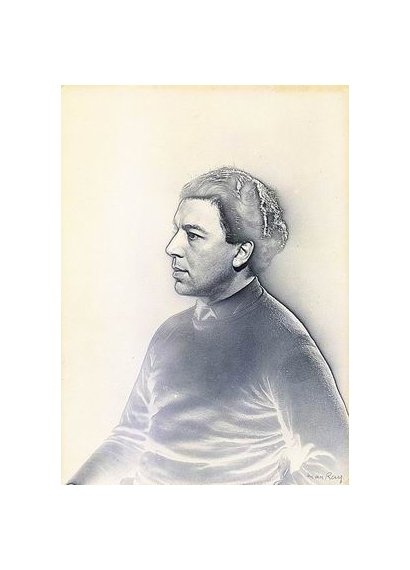Man Ray
What is there to love about Man Ray’s photography? Well, he was a photographer of many genres: portraits, fashion, nudes, still life, abstraction, composites and more. He embraced experimentation and the use of new processes such as solarisation and rayographs. He took traditional portraits especially of fellow artists as well as surrealist photographs. He was born Emmanuel Radnitsky in Philadelphia in 1890 but became Man Ray when his Jewish Russian immigrant family moved to New York. It was here that he met the photographer Alfred Stieglitz and his 291 gallery which introduced him to the European avant-garde. His first ambitions had been to be a painter but it wasn’t until he moved to Paris that he really became a photographer as he saw it as a means of making a living. He found he could be a commercial fashion photographer and his photographs were published in the US and French Vogue from 1924 onwards. He had already made a name for himself when Paul Poiret had asked Man Ray to photograph his fashion designs in 1921 and in the following year Man Ray had his own studio. It is the interwar period before he fled Paris for the US that Man Ray is best known.
Man Ray explored the female nude genre with a series of muses: Kiki de Montparnasse, Lee Miller, Meret Oppenheim and Ady (Adrienne Fidelin). Femininity, sexuality as well as the uncanny were popular subjects for the surrealists. He was above all an experimenter and was influential in using the darkroom as a way of creative expression. He even did away with the camera to create rayographs and combined these sometimes with photos most notably he created Ingres’s violin in 1924. Together with Lee Miller, the technique of solarisation was discovered. Man Ray took a photograph of La Merchesa Casati in 1922. It was a long pose in dim light that resulted in two pairs of eyes being revealed one above the other. Man’s immediate reaction was that this was a worthless mistake. The Marchesa on the other hand felt the photo had portrayed her soul. So ‘mistakes’ in the processing and mistakes in the camera became to be regarded as art. Man Ray enjoyed working with not only his models, but also his contemporary artist friends. A particularly good example of this was his collaboration with Paul Eluard and his recently married second wife, Nusch. Photographs of the beautiful and gracefull Nusch in the nude were combined with Paul Eluard’s poems expressing his love for Nusch. Man Ray and Paul Eluard also collaborated in Les Mains libres 1937. Here Eluard added poems to Ray’s more than sixty pen and ink drawings.
Man Ray broke away from his contemporaries in the Stieglitz circle that were modernists advocating purely unmanipulated and realist photography. These modernists had themselves reacted against the more impressionist pictorialists. Man Ray looked toward photography as a malleable medium where the photographer could become an artist. Marcel Duchamp commented succinctly that it was Man Ray’s “achievement to treat the camera as he treated the paintbrush, as a mere instrument in the service of the mind’. Duchamp and Man Ray were long term friends and together they collaborated on pushing the boundaries of gender identity and representation many years prior to today’s focus on these issues. So Man Ray was both a man of his time but also his conceptual approach and innovative techniques liberated photography of its constraints and opened up new ways of thinking artistically using the tools of photography.
Le violon d‘Ingres 1924
Glass Tears 1932
Kiki de Montparnasse 1924
Lee Miller 1930
Solarize portrait of Lee Miller 1930
Luisa Casati 1922
Berenice Abbott 1921
Virginia Woolf 1935
Facile 1935
Facile 1935
Les Mains libres Man Ray and Paul Eluard 1937
Noir et Blanche 1926
Rrose Selavy alias Marcel Duchamp 1921
Peggy Guggenheim 1924
Veiled Erotic Meret Oppenheim 1933
Salvador Dali c. 1929
Pablo Picasso 1921
Kiki de Montparnasse 1925
Andre Breton 1932
Avoue le ciel n’est pas sérieux Ce matin n’est qu’un jeu sur ta bouche de joie Le soleil se prend dans sa toile
Nous conduisons l’eau pure et toute perfection Vers l’éta diluvien Sur une mer qui a la forme et la couleur de ton corps Ravie de ses tempêtes qui lui font robe neuve Capricieuse et chaude Changeante comme moi
Ô mes raisons le loir en a plus de dormir Que moi d’en découvrir de valables à la vie A moins d’aimer
En passe de devenir caresses Tes rires et tes gestes règlent mon allure Poliraient les pavés Et je ris avec toi et je te crois toute seule
Tout le temps d’une rue qui n’en finit pas.
Tu te lèves l’eau se déplie Tu te couches l’eau s’épanouit
Tu es l’eau détournée de ses abîmes Tu es la terre qui prend racine Et sur laquelle tout s’établit
Tu fais des bulles de silence dans le désert des bruits Tu chantes des hymnes nocturnes sur les cordes de l’arc-en-ciel Tu es partout tu abolis toutes les routes
Tu sacrifies le temps A l’éternelle jeunesse de la flamme exacte Que voile la nature en la reproduisant
Femme tu mets au monde un corps toujours pareil Le tien
Tu es la ressemblance.



















